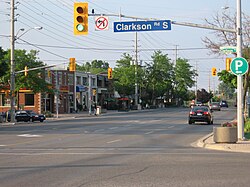Clarkson, Mississauga
| Clarkson | |
|---|---|
| Neighbourhood | |

Clarkson Village, looking eastward at the corner of Lakeshore Road West and Clarkson Road South
|
|
 Clarkson Village welcome sign, at Lakeshore Road West and Inverhouse Drive. |
|
| Coordinates: 43°31′9″N 79°38′2″W / 43.51917°N 79.63389°W | |
| Country | Canada |
| Province | Ontario |
| Regional municipality | Peel |
| City | Mississauga |
| Established | 1808 |
| Time zone | Eastern (UTC-5) |
| • Summer (DST) | Eastern (UTC-4) |
| Forward sortation area | L5J |
| Area code(s) | 905 and 289 |
| NTS Map | 030M12 |
| GNBC Code | FAREC |
Clarkson Village is a neighbourhood in the city of Mississauga, Ontario, Canada, situated in the southwest corner of the city, along the shore of Lake Ontario. It is bordered by Lake Ontario to the south, Oakville to the west, Erindale and Erin Mills to the north, and Lorne Park to the east.
In 1808, fifteen-year-old Warren Clarkson and his brother Joshua left their home in Albany, New York to seek their fortune in Canada. They had been invited to come work for a friend of the family who had bought land near Lake Ontario. Warren liked the area very much and decided to stay. He worked hard so that someday he would be able to own property. When he was twenty-six he had saved enough money to buy land and build a home. Warren married and began to raise a family. As the years went by Warren bought more land. He built the community's first store along the stagecoach trail. Fifteen years later the town council named this trail Clarkson Road.
A post office was opened in the family store and William Clarkson, Warren's son became the postmaster. For the next forty five years a member of the Clarkson family would run the post office. Clarkson community never grew very large. It had a few houses and shops along Clarkson Road, a railway station, a school, and a church. Less than one hundred people lived in this quiet community.
In 1856, Captain Edward Sutherland (1794-1885) moved to Clarkson with his seven children. A widower, he purchased "Bush's Inn," a former inn and coach house that was the halfway point between Hamilton, Ontario and Toronto (this building, a private residence, still stands on Clarkson Road South). Here, he is said to have introduced both strawberry and raspberry cultivation to the area. Clarkson eventually became the "Strawberry Capital of Ontario," and commercial fruit farming expanded in the area through the rest of the 19th and into the early 20th century. In 1915, a sign was erected at the Clarkson railway station declaring "Through this station passes more strawberries than any other station in Ontario." The Sutherlands later became connected by marriage to the Harrises of Benares (see "Sites of Interest" below).
...
Wikipedia
